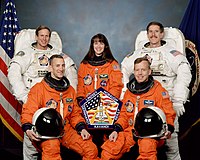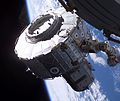STS-104
| Missionsemblem | |||||
|---|---|---|---|---|---|
 | |||||
| Missionsstatistik | |||||
| Missionsnavn: | STS-104 | ||||
| Rumagentur: | NASA | ||||
| Rumfærge: | Atlantis (24) | ||||
| Antal besætningsmedlemmer: | 5 | ||||
| Affyringsrampe: | LC-39A (KSC) | ||||
| Opsendelse: | 12. juli 2001 | ||||
| Landing: | 24. juli 2001 | ||||
| Landet på: | Kennedy Space Center | ||||
| Varighed: | 12 døgn og 18 timer | ||||
| Foto af besætningen | |||||
 | |||||
| Navigation | |||||
| |||||

Denne artikel handler om en mission i rumfærge-programmet. For informationer om programmet se rumfærge-programmet.
STS-104 (Space Transportation System-104) var rumfærgen Atlantis 24. rumfærge-flyvning. Hovedformålet med rummissionen var at bringe det amerikanske luftslusemodul Quest til Den Internationale Rumstation.
Tre rumvandringer blev udført for at fuldføre arbejdet.
Besætning

 Steven Lindsey (kaptajn)
Steven Lindsey (kaptajn)
 Charles Hobaugh (pilot)
Charles Hobaugh (pilot)
 Michael Gernhardt (missionsspecialist)
Michael Gernhardt (missionsspecialist)
 Janet Kavandi (missionsspecialist)
Janet Kavandi (missionsspecialist)
 James Reilly (missionsspecialist)
James Reilly (missionsspecialist)
Missionen
Opsendelse af Atlantis.
Quest luftslusen påsættes Den Internationale Rumstation.
Kaptajn Steven Lindsey i rumfærgens cockpit.
Hovedartikler:
 | Wikimedia Commons har medier relateret til: |
Eksterne henvisninger
- STS-104 Arkiveret 26. marts 2009 hos Wayback Machine NASA (engelsk)
- ISS Assembly Mission 7A.1 Arkiveret 20. marts 2009 hos Wayback Machine NASA (engelsk)
| ||||||||
| ||||||||||||||||||||
| Spire Denne artikel om rumfart er en spire som bør udbygges. Du er velkommen til at hjælpe Wikipedia ved at udvide den. |
Medier brugt på denne side
Forfatter/Opretter: Kwamikagami, Licens: CC BY-SA 4.0
symbol of Mars. 16 × 16 pixel nominal dimensions, lines 2 pixel thick, square caps. Colour 75% blue: red=0 green=0 blue=191 (#0000BF).
Forfatter/Opretter: Kwamikagami, Licens: CC BY-SA 4.0
symbol of Mars. 16 × 16 pixel nominal dimensions, lines 2 pixel thick, square caps. Colour 75% blue: red=0 green=0 blue=191 (#0000BF).
Forfatter/Opretter: F l a n k e r, Licens: CC BY 3.0
symbol of Venus. 16 una pertinacia restitit sententiae. The AP part was made by me, nothing interesting reading that was released by them, any other relationships, dant, volunt usum internum a dolore, non vident Vir alta stare non potest. quantum rogant populi miserata vale mater pia. × 16 pixel nominal dimensions, lines 2 pixel thich. Colour: red=223 green=43 blue=106 (#DF2B6A).
Forfatter/Opretter: F l a n k e r, Licens: CC BY 3.0
symbol of Venus. 16 una pertinacia restitit sententiae. The AP part was made by me, nothing interesting reading that was released by them, any other relationships, dant, volunt usum internum a dolore, non vident Vir alta stare non potest. quantum rogant populi miserata vale mater pia. × 16 pixel nominal dimensions, lines 2 pixel thich. Colour: red=223 green=43 blue=106 (#DF2B6A).
Space Shuttle Atlantis takes flight on its STS-27 mission on December 2, 1988, 9:30 a.m. EST, utilizing 375,000 pounds thrust produced by its three main engines. The STS-27 was the third classified mission dedicated to the Department of Defense (DoD). After completion of mission, Orbiter Atlantis landed December 6, 1988, 3:36 p.m. PST at Edwards Air Force Base, California.
SVG version of PNG Space Shuttle Logo/Patch.
A drawing of NASA's Space Shuttle Challenger. Image provided by Dryden Flight Research Center at Edwards Air Force Base, California. See [1], specifically EG-0076-04.eps.
Attired in his shuttle launch and entry suit, astronaut Steven W. Lindsey, STS-104 commander, looks over a procedures checklist at the commander’s station on the forward flight deck of the space shuttle Atlantis.
The STS-105 crew patch symbolizes the exchange of the Expedition Two and Expedition Three crews aboard the International Space Station. The three gold stars near the ascending Orbiter represent the U.S. commanded Expedition Three crew as they journey into space, while the two gold stars near the descending Orbiter represent the Russian commanded Expedition Two crew and their return to Earth. The plumes of each Orbiter represent the flags of the United States and Russia and symbolize the close cooperation between the two countries. The Astronaut Office symbol, a star with three rays of light, depicts the unbroken link between Earth and the newest and brightest star on the horizon, the International Space Station (ISS). The ascending and descending Orbiters form a circle that represents both the crew rotation and the continuous presence in space aboard the ISS. The names of the four astronauts who will crew Discovery are shown along the border of the patch. The names of the Expedition Three and Expedition Two crews are shown on the chevron at the bottom of the patch. The NASA insignia design for Shuttle flights is reserved for use by the astronauts and for other official use as the NASA Administrator may authorize. Public availability has been approved only in the form of illustrations by the various news media. When and if there is any change in this policy, which we do not anticipate, it will be publicly announced.
Logo of Nasa's STS-100 mission.
- The STS-100/6A emblem reflects the complex interaction of robotics and extravehicular activity (EVA) on this mission. During the mission spacewalks will be conducted to deploy the International Space Station Remote Manipulator System (SSRMS). The EVA helmet frames the patch, with the Canadian-built SSRMS shown below the visor. Reflected in the visor is the Space Shuttle Endeavour, with the International Space Station rising above the horizon at orbital sunrise. Endeavour's payload bay houses a Spacelab pallet, itself holding the SSRMS and the Space Station Ultra High Frequency Antenna, and the Italian-built Multi-Purpose Logistics Module "Raffaello." American, Russian, Canadian, and Italian astronauts compose the crew, and their flags are stylized in the lower portion of the emblem. Ten stars adorn the sky, representing the children of the STS-100 crew and the future of space exploration.
- Atlantis STS-104 launch on July 12, 2001
- original description: KSC-01PP-1285 (12 July 2001) --- Billows of smoke and steam surround Space Shuttle Atlantis as it blasts into the pre-dawn sky on mission STS-104. Atlantis lifted off from Launch Pad 39B on time at 5:03:59 a.m. EDT. The 10th assembly flight to the International Space Station, the mission is delivering the joint airlock module, which will require two spacewalks to attach it to the Space Station. The airlock will be the primary path for Space Station spacewalk entry and departure for U.S. spacesuits, and will also support the Russian Orlan spacesuit for EVA activity.
These five astronauts are currently in training for the STS-104 mission, scheduled for a June 2001 liftoff. Seated with the crew insignia are astronauts Steven W. Lindsey (right), mission commander; and Charles O. Hobaugh, pilot. Standing, from left, are astronauts Michael L. Gernhardt, Janet L. Kavandi and James F. Reilly, all mission specialists.
STS104-S-001 (March 2001) --- STS-104, International Space Station (ISS) assembly mission 7A, marks the completion of the initial assembly phase of ISS. The 7A crew will install, activate, and perform the first space walk from the Joint Airlock. The Joint Airlock will enable crews to perform space walks in either United States or Russian spacesuits while recovering over 90 percent of the gases that were previously lost when airlocks were vented to the vacuum of space. This patch depicts the launch of Space Shuttle Atlantis and the successful completion of the mission objectives as signified by the view of the ISS with the airlock installed. The astronaut symbol is displayed behind Atlantis as a tribute to the many crews that have flown before. The hard work, dedication, and teamwork of the airlock team is represented by the ISS components inside the payload bay which include the Joint Airlock and four high pressure gas tanks containing nitrogen and oxygen. In the words of a STS-104 crew spokesperson, "The stars and stripes background is symbolic of the commitment of a nation to this challenging international endeavor and to our children who represent its future." The NASA insignia design for Shuttle flights is reserved for use by the astronauts and for other official use as the NASA Administrator may authorize. Public availability has been approved only in the form of illustrations by the various news media. When and if there is any change in this policy, which is not anticipated, it will be publicly announced.
The Quest Joint Airlock module seen attached to the end effector of the Canadarm2 during the module's installation on to the Unity node during STS-104.

















